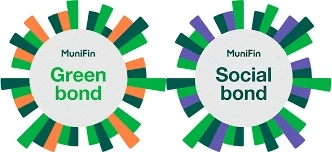Around $500 billion in sustainable bonds will be issued in 2020, a new yearly high. The demand for these bonds has been significant; one recent example is the Italian government's green bond issue, which was 10 times oversubscribed. Continue to read and we will help you to get a better understanding about the sustainability bonds.
Green bonds
The issuance of green bonds has increased exponentially since the first one was issued in 2007 by the European Investment Bank, with more than $1 trillion already having been issued. Green bonds are used to fund or refinance projects with obvious environmental advantages. The following are some examples of initiatives that might be funded:
Energy from renewable sourcesBuilding renovations, for example, can help with energy efficiency.Agriculture that is environmentally friendlySustainable water management is an example of a natural resource.Mitigation or adaptation to climate change?Daimler and Volkswagen, for example, had two big green bond issuances in 2020. To help the firms' shift to electric cars, EUR 1 billion and EUR 2 billion were raised, respectively.Social Bonds
Social bonds, like green bonds, were created in response to a growing awareness of global environmental and climatic concerns. They were created to solve social difficulties that endanger, impede, or harm society or a specific community. The number of social bonds issued in 2020 was over ten times that of 2019, and this trend is anticipated to continue as governments and corporations issue bonds to aid in the post-COVID recovery. They may be able to fund initiatives such as:
Creating essential infrastructure that is cheap, such as clean drinking water and sanitationHealth and education are both accessible.ensuring adequate foodEcuador, for example, has issued a social bond to help fund affordable housing, while Russia's Sovcombank has issued a bond to help fund zero-interest loans that allow low-income people to buy things on credit.Sustainability Bonds
A sustainability bond funds initiatives that aim to achieve both environmental and social advantages, as projects with environmental benefits frequently also have social benefits, and vice versa.
Sustainability bonds were issued in 2020 by large US financial companies such as JP Morgan, Goldman Sachs, Bank of America, and Mastercard to fund sectors such as renewable energy and affordable housing.
ICMA says a Sustainable Bond is a senior unsecured bond having the same financial and contractual conditions as other senior unsecured bonds. The issuer makes the following extra promises when issuing a Sustainable Bond:
Allocate the profits from the bonds to green and/or social projects or expenditures that meet a set of Eligibility Criteria.
Provide investors with a report on the projects that were financed with the funds from the Sustainability Bond. Sustainability Bonds are widely regarded as a highly intriguing tool for attracting additional investment for sustainable projects, owing to the fact that they are a simple product that is easily accessible to any ethical investor and rely on existing big issuer investments.
Bonds are not just labels
Bonds cannot just be labeled as green, social, or sustainable; they must also satisfy specific requirements. To begin, the issuer must explain the method they utilized to evaluate and choose the project. They must also explain how they plan to manage the bond revenues and provide frequent updates on how the funds were used. Throughout the process, there is a focus on conveying the project's environmental sustainability goal and ensuring that the effect is realized. External evaluation of the bond is advised and standard practice to ensure that all of these procedures are followed.
Despite the rigor involved in issuing green, social, and sustainability bonds, one criticism is that they are vulnerable to greenwashing since they are built around how the bond profits will be utilized, and there are no repercussions for not utilizing the proceeds as indicated. Another criticism is that so-called brown firms can issue sustainable bonds to fund a tiny portion of their operations while continuing to operate as usual.
Sustainability linked bonds
Sustainability linked bonds (SLB) are a fourth form of bond that attempts to address these issues. These are used for the issuer's normal financing requirements, but they are conditional on the issuer meeting certain sustainability/environmental, social, and/or governance (ESG) criteria. The financial and/or structural features of the bond can change based on whether the issuer's key performance indicators (KPIs) meet set sustainability performance objectives.
The coupon, maturity, or payback amount, for example, may fluctuate based on whether the issuer accomplishes its aim of reducing carbon emissions or achieving an ESG-related goal. Seaspan's 2021 issue is an excellent example: if it doesn't spend $200 million upgrading or purchasing ships to operate on lower-carbon fuels within three years, it will pay investors an additional 50 basis points.
Other important facts to keep in mind
The International Capital Market Association (ICMA) serves as the secretariat for the framework and principles that underpin these bonds, as well as maintaining a database that tracks the growing number of bonds issued. In fact, the bonds have grown in popularity to the point that certain stock markets have a section dedicated to them.
Risk managers should be mindful of the "greenium" implications for these bonds, as the yield on green bonds is frequently lower than the yield on regular bonds from the same issuer. Because the issuer's credit risk is being underpriced as a trade-off for investing in the bonds, it's possible that the issuer's credit risk is being underpriced. Failure to receive a sufficient return on the credit risk may result in future issues.
Social, green, and sustainability bonds are utilized by a wide spectrum of issuers, from sovereigns and development banks to corporations and financial institutions, according to the Climate Bonds Initiative. They're also utilized in a range of industries. Understanding the features of these bonds, which are being created in response to societal needs and climate change, will aid risk managers in determining what is driving the growth in volumes and risk-return trade-offs.


